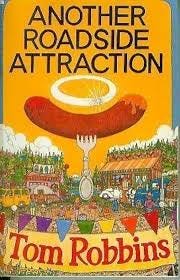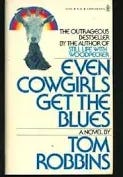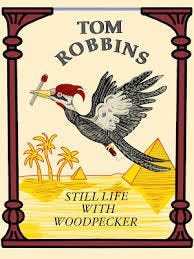Sign up for a wild ride with Robbins
Author Tom Robbins' books are, well, indescribable - in a good way!
The titles alone ought to make you wonder. “Still Life With Woodpecker.” “Even Cowgirls Get The Blues” “Another Roadside Attraction” “Jitterbug Perfume.”
Author Tom Robbins’ books aren’t like anyone else’s. They are funny, intricate, mystical, wild, thoughtful, strange and maybe the best term for them — untamed.
The first Tom Robbins’ piece I ever read was an excerpt from “Still Life With Woodpecker” that ran in Esquire Magazine.
And in that excerpt, Robbins goes on at incredible, mind-blowing length about the images you’d find on a pack of Camel cigarettes, what they imply (at least to him) and by turns, it’s funny, thoughtful, strange, out-there but a fun roller coaster read.
There really isn’t anybody quite like him. Hunter Thompson, I suppose, comes to mind but Thompson’s stories were generally grounded in journalism; those were sort of the base rules that he was gleefully willing to shatter.
Robbins’ imagination has no bounds, at least none that are apparent, so when he concocts a story, you never know where it might veer. Like in “Another Roadside Attraction” a Washington native swipes the mummified body of Jesus Christ.



In “Still Life With Woodpecker,” well, let’s share the Wikipedia explanation: Still Life With Woodpecker (1980) is the third novel by Tom Robbins, concerning the love affair between an environmentalist princess and an outlaw. The novel encompasses a broad range of topics, from aliens and redheads to consumerism, the building of bombs, romance, royalty, the Moon, and a pack of Camel cigarettes. The novel continuously addresses the question of "how to make love stay" and is sometimes referred to as "a post-modern fairy tale".
That’s about it: Good job, Wikipedia.
So, after reading “Meditations On A Camel Pack” which I completed one afternoon, lying on the couch in my living room (I can still remember it!), I got up, walked into my den and wrote a short story about Johnny Rotten of the Sex Pistols and when Bob Dylan made the decision to go into religious songs, which was later published in a Boston cheap magazine that doesn’t exist any more. (My story might have helped)
After reading “Still Life” I read Robbins’ other two, “Another Roadside Attraction” and “Even Cowgirls Get The Blues” which was later made into a movie. (Never saw it). As a writer, Robbins gets your brain to go wide —- does that make sense? I’m not sure that is clear but I’m not sure I could think of another way to describe how the guy writes. But most of all, it’s FUN.
He’s 92 now, his writing days are long past, but his voice is just so unusual, I thought it’d be fun to share a little bit of my experiences with the guy’s writing with my Substack friends.
His background is, as you might expect, a wild one. He briefly attended Washington and Lee University, got dismissed for bad behavior, became a meteorologist in Korea, served in the Special Weather Intelligence unit of the Strategic Air Command, worked on the Sports Desk of the Richmond Times-Dispatch, did radio shows, wrote reviews on art and a column for Artforum, worked on the copy desk on the weekend for the Seattle Post-Intelligencer, lived on an Indian reservation and you know, got around.
And, uh, well, rather than ME, tell you about his writing, here’s a little excerpt from “Meditations.” (Can you imagine an editor at Esquire getting handed THIS?)
They do not set my mind to whizzing, as can the literature on certain other packages. Cheerios, for example. On the right side-panel of the verbose and somewhat tautological box of Cheerios, it is written: If you are not satisfied with the quality and/or performance of the CHEERIOS in this box, send name, address, and reason for dissatisfaction—along with entire box-top and price paid—to :General Mills, Inc. Minneapolis, Minn. 55460 Your purchase price will be returned. It isn’t enough that there is a defensive tone to those words, a slant of doubt, an unappetizing broaching of the subject of money. They also leave the reader puzzling over exactly what might be meant by the “performance” of the Cheerios. Could the Cheerios be in bad voice? Might they not handle well on curves? Do they ejaculate too quickly? Has age affected their timing, or are they merely in a midseason slump? Afflicted with nervous exhaustion or broken hearts, are the Cheerios smiling bravely, insisting that the show must go on? One thing you can say for the inscription: it makes you want to rush to the pantry, seize a box of Cheerios, rip back its tab (being careful not to tear it lest there come a time to send in the box-top, which must be, remember, entire), part the waxed-paper inner bag with both hands, dispatch a significant minority of the Cheerio population head over heels into a bowl, douse them immediately with a quantity of milk (presumably they do not perform when dry), sprinkle some white sugar on top, and then crouch, face close to the bowl, watching, evaluating, as the tiny, tan, lightweight oat doughnuts, irregular in size, tone, and texture, begin to soak up the milk and the sugar granules dissolved therein, growing soft and soggy, expanding somewhat as they absorb liquid; and you may be thinking all the while about the toroid shape—the shape of the cyclone, the vortex, the whirlpool, the shape of a thing made of itself yet mysteriously distinct from itself—thinking about rings, halos, men overboard, the unbroken cycle of life, the void as nucleus, or, best of all, bodily orifices; thinking about whatever the trove of toroidal trinkets might inspire as, center holes flooded with sugary milk, they relax and go blobby in the bowl; but appraising even as your mind wanders, appraising, testing, criticizing, asking repeatedly: do Cheerios measure up to Wheaties with beer, do they work well with others, do they crack under pressure, would Ed Sullivan have signed them, would Knute Rockne have recruited them, would Warren Beatty have dated them, how well do these little mothers perform? At times like these, you understand what the man meant when he said he’d walk a mile for a Camel. SPACE IS SIMPLY A DEVICE to keep everything from being in the same place. As I meditate, the space around me comes to be less defined by the walls of my room and more defined by the Camel pack. The Camel pack is a rectangular solid (more precisely, a right rectangular parallelepiped) two and three-quarters inches high, two and one-eighth inches wide, and seven eighths of an inch deep. Imagine my eyes crawling over every crinkle in the cellophane. Imagine me gazing expectantly, my eyes like a couple of goldfish with insufficient water in their bowls. Indeed, as an environmentalist, I might have been more interested in a fishbowl. Not only does a bowl have a benevolent, ecologically sound function, but its round shape—as biomorphic as a breast, melon, or moon—evokes the natural world.”
Does that give you an idea? Funny enough, I was just a crazy enough teacher to share Robbins’ “Meditations” article with my Advanced Placement English Literature class a few years ago. And even crazier, the one sweet loyal student of mine who’d taken three of my classes and didn’t seem to find any particular story or play got her excited, she came in one day and told me she LOVED TOM ROBBINS! Her writing took a leap, her work improved and all of a sudden, she was speaking out in class, a different kid.
Will Tom Robbins’ books do that for you? Give ‘em a try.
HERE’S WHAT I SHARED WITH MY CLASS:
https://classic.esquire.com/article/1980/7/1/meditations-on-a-camel-pack




